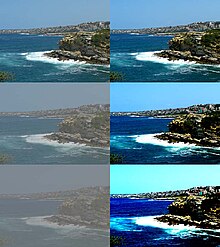
Back Kontras (visie) Afrikaans تباين (بصريات) Arabic Кантраст Byelorussian Контраст Bulgarian Contrast (visió) Catalan Kontrast (lys) Danish Kontrast German Kontrasto Esperanto Contraste Spanish Kontrastsus Estonian

Contrast is the difference in luminance or color that makes an object (or its representation in an image or display) visible against a background of different luminance or color.[1] The human visual system is more sensitive to contrast than to absolute luminance; thus, we can perceive the world similarly despite significant changes in illumination throughout the day or across different locations.[2]
The maximum contrast of an image is termed the contrast ratio or dynamic range. In images where the contrast ratio approaches the maximum possible for the medium, there is a conservation of contrast. In such cases, increasing contrast in certain parts of the image will necessarily result in a decrease in contrast elsewhere. Brightening an image increases contrast in darker areas but decreases it in brighter areas; conversely, darkening the image will have the opposite effect. Bleach bypass reduces contrast in the darkest and brightest parts of an image while enhancing luminance contrast in areas of intermediate brightness.
- ^ Pelli, Denis G.; Bex, Peter (September 2013). "Measuring contrast sensitivity". Vision Research. 90: 10–14. doi:10.1016/j.visres.2013.04.015. PMC 3744596. PMID 23643905.
- ^ Rahimi-Nasrabadi, Hamed; Jin, Jianzhong; Mazade, Reece; Pons, Carmen; Najafian, Sohrab; Alonso, Jose-Manuel (2021-02-02). "Image luminance changes contrast sensitivity in visual cortex". Cell Reports. 34 (5): 108692. doi:10.1016/j.celrep.2021.108692. PMC 7886026. PMID 33535047.